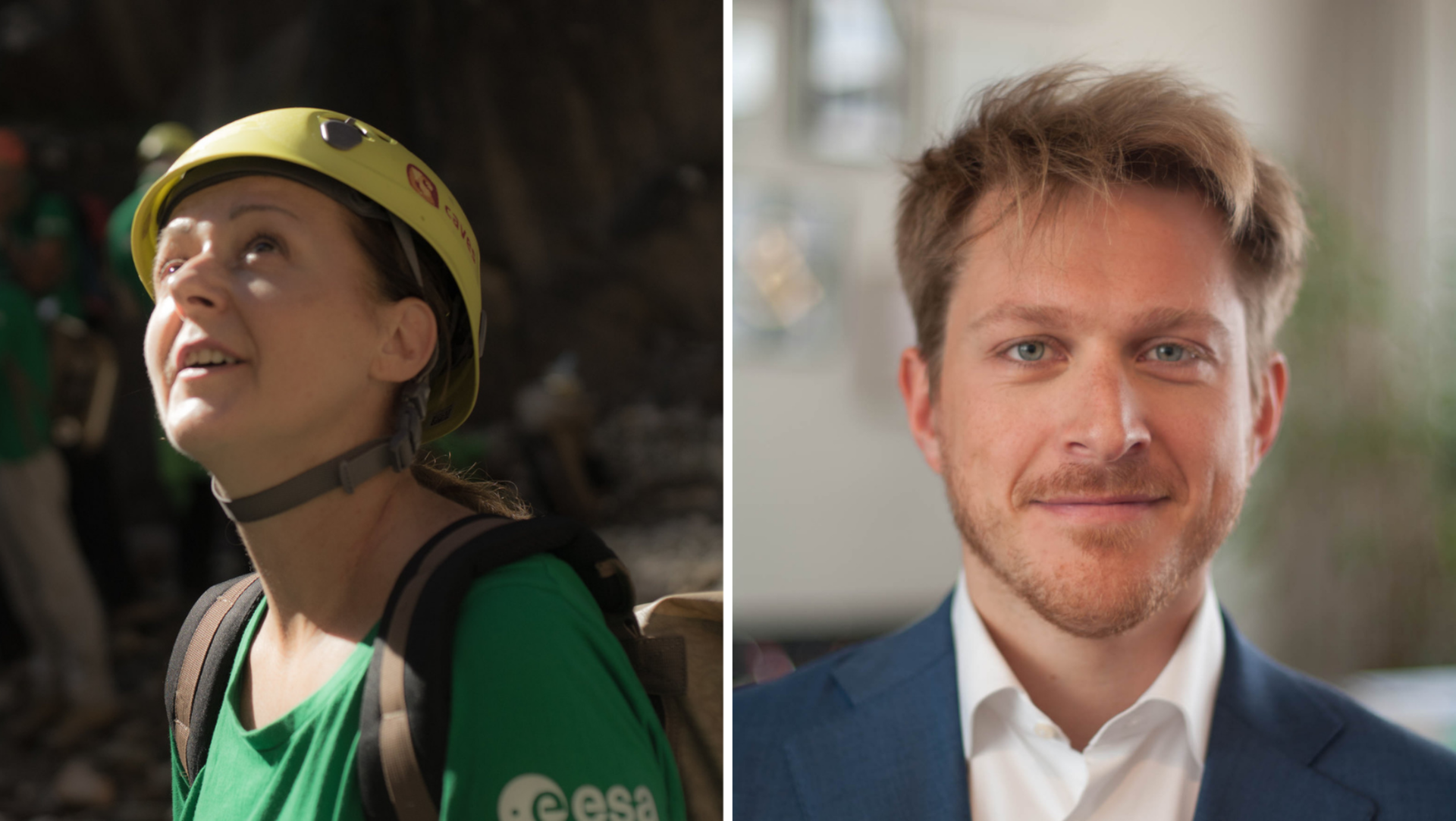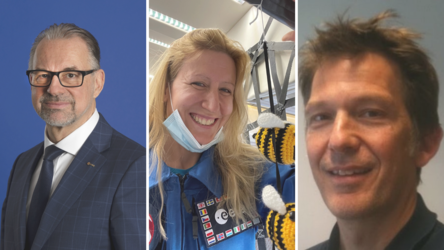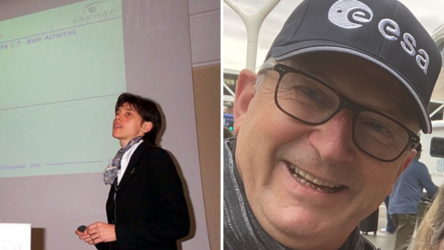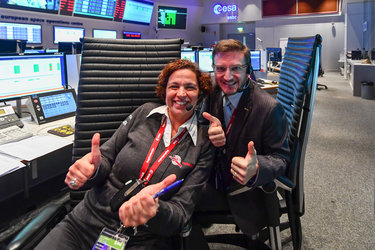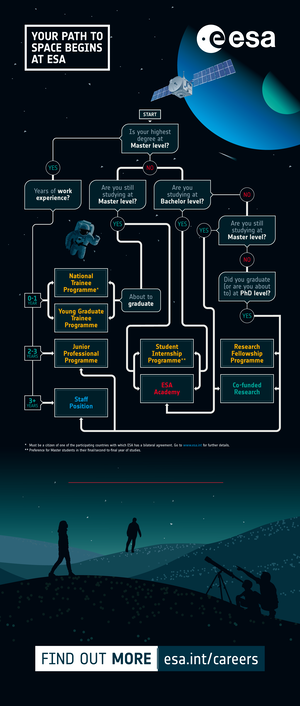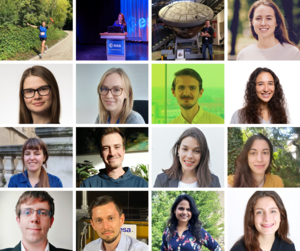Part 2: YGTs – Where are they now?
Ever wondered where ESA’s former Young Graduate Trainees are today? For part two of the series ‘YGTs – Where are they now?’ we continue our interviews with YGT alumni to talk about their career paths leading up to, during and after their YGT experience. Read on to find out where alumni of the YGT Programme are today and stay tuned for the next publication!
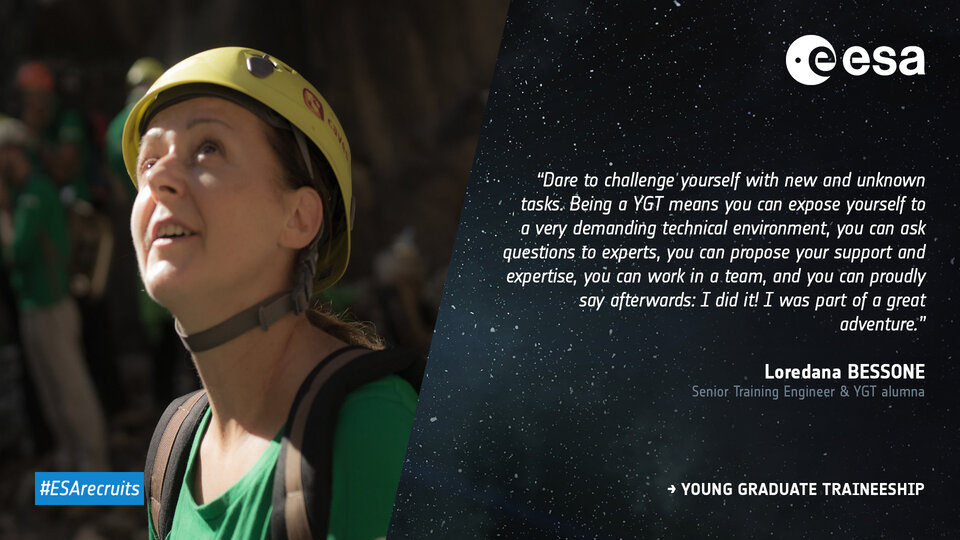
Current main project(s): ESA CAVES & PANGAEA, Electronic Field Book
Years as a YGT: 1991
What was your background/experience before becoming a YGT?
I had a degree in Computer Science, worked as a consultant and as an instructor of computer software, spent three months as a summer student and one year as a technical student at CERN.
Why did you apply to become a YGT?
I was a technical student at CERN and wanted to get more experience in an international environment. My experience at CERN was exhilarating and offered me a perspective that I had not imagined during my years at university. I had been working in the same group as Tim Berners-Lee and my code was being used to develop data acquisition for large particle physics detectors.
What did you work on as a YGT?
I started in a very small astronaut centre as a computer engineer. My boss at the time kept telling me I was not a helpdesk, but I really was. I inherited a series of desktop computers with MS-DOS and no LAN and pretty soon decided to transform it into a LAN with Windows and centralised administration.
What is your most memorable or challenging moment as a YGT?
Arriving at EAC, in a place called Porz, where nobody had a clue where ESA was, and few even knew the DLR campus, on a cold snowy December day. No mobiles at the time, no satnav, and lots of non-English speaking Germans who kept telling me that there were many places called Porz, so which one was I looking for?
Where did your path lead to after your YGT experience?
I was offered a job at EAC where I was responsible for the technical infrastructure at EAC. My experiences brought me to the training and operation world and established the Astronaut Training Database, an instructional IT system that is used in all phases of Space Training at ESA.

Since my background is in computer engineering, I decided to increase my space knowledge by doing a Master’s in Space System Engineering. I then became responsible for the Human Mars Mission studies in the ESA Concurrent Design Facility. After that, I was involved in establishing the ESA EVA training programme in the EAC Neutral Buoyancy Facility, and I organised the Survival training for the Shenanigans09. Next, I developed the CAVES and PANGAEA training programmes and my team is also developing the Electronic Field Book tool suite, which supports geological field operations.
How did the YGT help you in your future career?
The YGT opportunity was my springboard. I would probably never have applied for a job at ESA otherwise. My job has changed a lot since I was a YGT. Getting a high level of responsibility and exposure to a very multinational and multidisciplinary environment provided me with the confidence and skills I needed to then jump into any new challenge my position at EAC presented me with, or that I had the opportunity to get involved in.
What advice do you have for a future YGT applicant?
Look for any opportunity and niche, even if it is challenging, and work hard at becoming an expert in that field. Use and respect expertise from others. Always openly and honestly communicate with everybody. Consider your knowledge an asset, but never a power tool. Be assertive in expressing your needs and idea. Be a considerate team member. Never ever stop learning. Make sure you love your job.
As a last question, we asked the current YGTs to send us questions for the YGT alumni to answer that they believed would be valuable for applicants to hear about. The question picked by Loredana is:
What makes the YGT unique in relation to other similar programmes?
For me it was very similar to the technical studentship at CERN, but YGT was post-graduation. I believe the duration of the YGT opportunity allows you to get enough insight into a specific job. It can be a springboard to your career. It was for me, but also for most of the YGTs who worked with me in my 30 years at ESA.
SMILE AIT/AIV & Launcher Interface Principal Engineer – Benjamin Vanoutryve
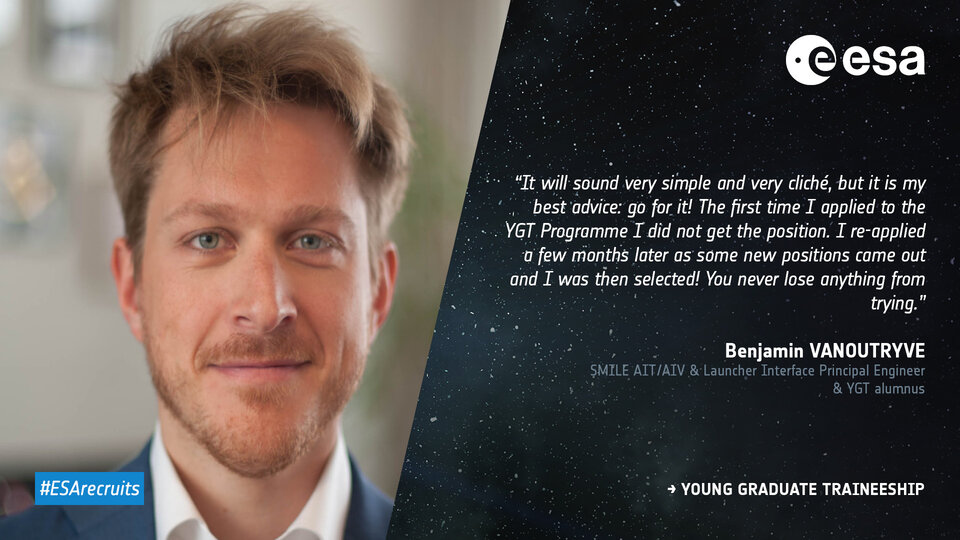
Current main project(s): SMILE
Years as a YGT: Sep-2009 to Feb-2011
What was your background/experience before becoming a YGT?
I wanted to work on planes or satellites since a very young age and therefore I studied aerospace engineering, first at the University of Liège in Belgium, and then at Supaero in Toulouse, France. During my Master thesis, I had my first contact with the European Space Agency as I spent my five-month internship at ESOC in Darmstadt, working together with the Mission Analysis team.
Why did you apply to become a YGT?
When I finished my aerospace engineering degree, I naturally thought of the European Space Agency as a dream place to start my career. I thought that the Agency was mostly reserved for people with a lot of work experience, but then I found out about the Young Graduate Trainee Programme and was immediately interested. I didn’t have to think long before applying!
What did you work on as a YGT?
I supported the ESA Lunar Lander Team on a wide variety of topics during the definition phase of the project. The most exciting one was to help find the best landing sites for the lander on the lunar south pole: the Moon’s rotation axis and terrain is such that there are places on the lunar poles that are almost permanently facing the Sun, which is of high interest for many reasons. Using just-released altimetry data from NASA’s LRO spacecraft, we ran long simulations and determined what could be the future landing sites of the next moon mission – robotic and even human!
What is your most memorable or challenging moment as a YGT?
This is difficult to answer as there have been many memorable moments during my YGT time. I’ll cheat and give two answers. On a professional side: the results of the moon landing site study were so interesting that we wrote a paper on them and I presented the findings in a conference in Barcelona. And on a more fun side: me and a couple of other YGTs in the Directorate of Human Spaceflight were allowed to go and visit the European Astronaut Centre in Cologne for a day. It was really cool to see the facilities and we also happened to come across some of the 2009 astronaut candidates.
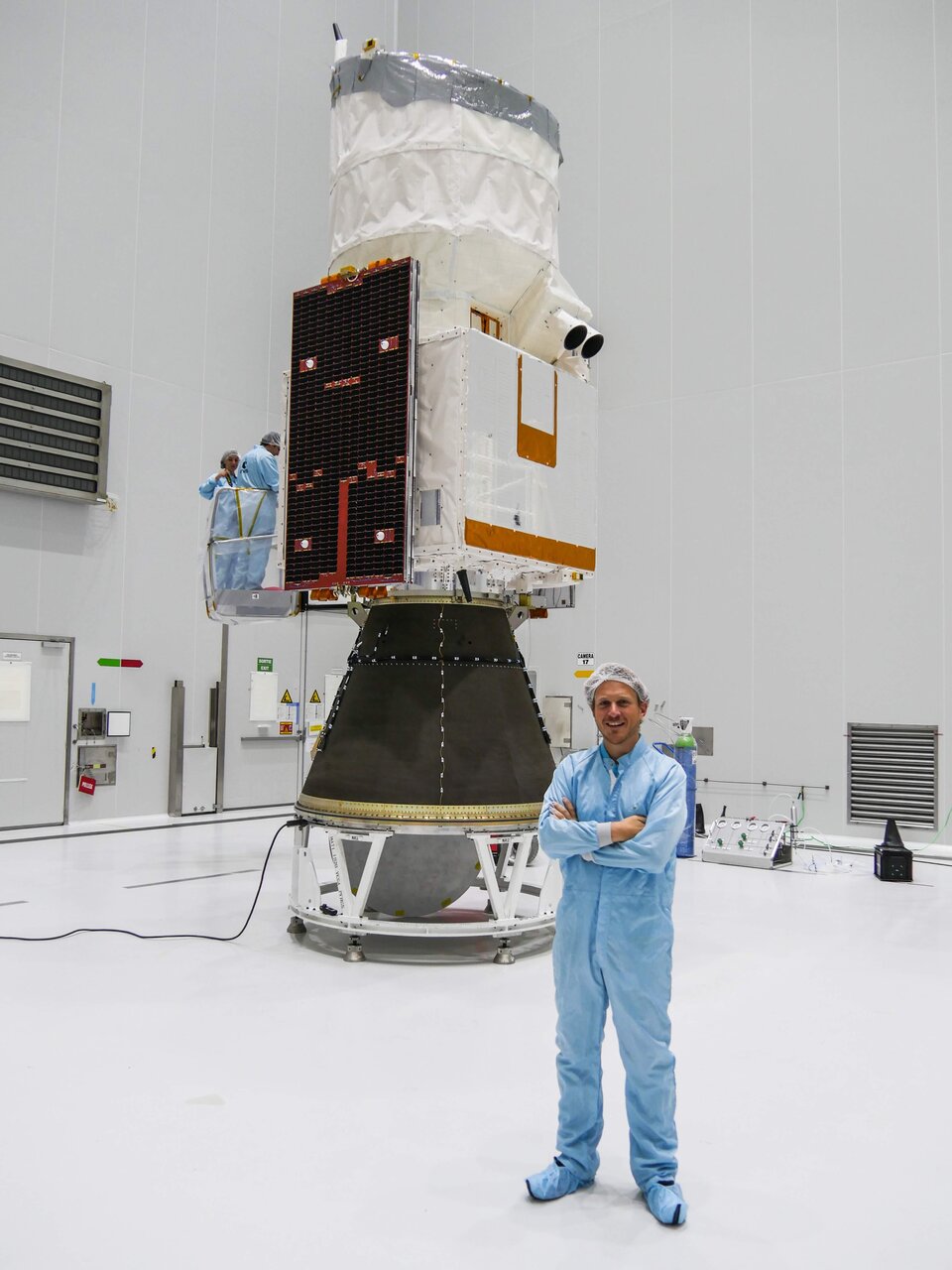
Where did your path lead to after your YGT experience?
One month before the end of my YGT placement, I had nowhere to go. Then, in the course of one week, I passed three interviews and had three job offers to choose from – so always keep hope! I chose to join a major satellite manufacturer in Germany, to help build future ESA spacecraft. It was really exciting to “use my hands” to help build something that would one day orbit planet Mars! I later moved to other projects in the industry, before joining ESA again a few years later.
After working for the Aeolus and Sentinel 2 projects, I recently became the SMILE AIT and Launcher Interface Principal Engineer. SMILE is a very interesting project in collaboration with the China National Space Administration. In a nutshell, I am responsible for ensuring that all the parts of the satellite, provided by different entities, correctly fit together and are ready for flight. I will also coordinate all the activities with the launch authority, up until the launch in just a few years from now. Exciting times ahead!
How did the YGT help you in your future career?
For me, the YGT experience was a perfect introduction to the European space sector: the role of ESA and that of the industry, how space projects are conducted, not just from a technical stand-point, but also the scientific and institutional aspects… It was also a perfect opportunity to meet many key actors of the sector, many of which I crossed path again later in my career and some that I still call friends today!
What advice do you have for a future YGT applicant?
It will sound very simple and very cliché, but it is my best advice: go for it! The first time I applied to the YGT Programme I did not get the position. I re-applied a few months later as some new positions came out and I was then selected! You never lose anything from trying.
As a last question, we asked the current YGTs to send us questions for the YGT alumni to answer that they believed would be valuable for applicants to hear about. The question picked by Benjamin is:
What are your thoughts on returning to ESA after gaining some industry experience?
We at ESA are lucky to work on some of the most interesting and challenging engineering projects on Earth, and we could not do it without the European space industry. In my opinion, it is essential to get to know both sides - agency and industry - in order to fully understand how it works. I’m very happy with where I am, but sometimes I am nostalgic about my days in the industry. Each side has its role and responsibilities; go experience both and form your opinion.
YGTs – Where are they now series
This is the final part to a three-part interview series where we have asked YGT alumni about their experience during the YGTs. Enjoy reading part one and part three here if you missed them.
How do I apply for a YGT opportunity?
The YGT call for applications has closed as of 28 February 2022; however, we may need to republish some opportunities. Stay tuned and set up a job alert on the ESA job site here so that are notified as soon as any opportunities go live.
Learn more about the YGT Programme.


